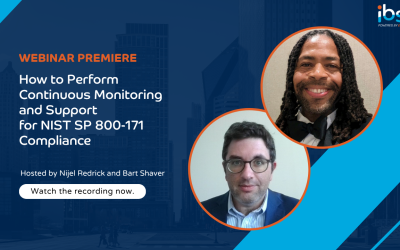As a government contractor, adherence to NIST SP 800-171 requirements is not just an option, but an essential mandate. Proactive preparation for compliance with these security requirements is crucial in order to avoid potential disruptions to your business operations. This blog is focused on the Incident Response security requirement as defined in NIST SP 800-171.
Key Takeaways
- The central principle of incident response is having a powerful operational incident-handling procedure that incorporates preparation, detection, analysis, containment, recovery, and user response.
- Security incidents have to be formally documented and these records must be adequately maintained. This process makes it easy for organizations to report threats and pass along the necessary information to track incidents.
- Testing reveals gaps in the incident response plan and allows cybersecurity teams to fix the problem before encountering real threats.
Understanding Incident Response
Incident response is a multi-phase process of detecting, responding to, and recovering from cyberattacks. It is a structured process to handle incidents and protect information and information systems. The goal of incident response is to promptly detect an attack, mitigate or minimize its impact, confine any resultant damage, and effectively address the root cause to diminish the likelihood of recurrence and to restore normal operations as soon as possible.
Planning for Incident Response
3.6.1. Establish an operational incident-handling capability for organizational systems that includes preparation, detection, analysis, containment, recovery, and user response activities. By integrating thorough preparatory steps, detection, analysis, containment, recovery strategies, and clear directives for users, the potential fallout from security breaches is substantially minimized. This strategy provides effective management of incidents, which safeguards essential informational assets while ensuring the continuity of business operations. Having this process in place enhances the resilience of organizations against cyber threats and also aligns with the overarching goal of maintaining operational stability when an incident has occurred.
3.6.2. Track, document, and report incidents to designated officials and/or authorities both internal and external to the organization. All system security incidents must have maintained records that include the status, trends, handling, evaluations, and any other necessary forensic information. Incident reports, incident response teams, audit monitoring, network monitoring, physical access monitoring, and user/administrator reports are examples of sources where incident information can be located. Suspicious activity would be reported using the suspected threat receipt. When reporting security incidents, cybersecurity professionals must follow the organization’s and federal guidelines for incident reporting. Incident reporting includes the types of security incidents reported, the content, timeline of the report, and the authority that will be reported in accordance with applicable laws, Executive Orders, directives, regulations, and policies.
3.6.3. Test the organizational incident response capability. Organizations should regularly test their incident response capabilities in order to identify potential weaknesses or deficiencies. Testing benefits organizations by improving response times, identifying delays, and training cyber teams to be more responsive. Many regulatory frameworks mandate regular testing to maintain compliance. Here are a few testing methods to consider:
- Walkthroughs: Review the Incident Response Plan step by step with the cybersecurity team to identify gaps or inconsistencies.
- Tabletop Exercises: Discuss hypothetical scenarios and refine any gaps in communication, roles, or decision-making procedures.
- Simulations: Conduct realistic simulations using tools to imitate a real world scenario. This allows for testing under pressure.
- Comprehensive Exercises: Combine elements of different testing methods for a comprehensive assessment.
Best Practices
Having a well-defined Incident Response Plan in place allows organizations to be prepared for cyberattacks. By following these steps, organizations can:
- Minimize the damage of cyberattacks, effectively respond, and get the organization back up and running promptly.
- Track, document, and maintain incident reports according to organizational and government requirements.
- Organize and thoroughly document incidents in the report.
- Incorporate regular updates and reviews of the Incident Response Plan to maintain business continuity .
- Stay current on technology, threats, and organizational structures.
Conducting periodic reviews and updates ensures that the Incident Response Plan evolves in tandem with the dynamic cyber threat landscape. Additionally, fostering a culture of cybersecurity awareness and training within the organization can significantly enhance the efficacy of the Incident Response Plan. By empowering employees with the knowledge and tools to recognize and respond to threats, organizations can establish a proactive stance against cyberattacks and minimize potential damages.
These are just a few examples of how to implement Incident Response whether you are a DoD Contractor or part of the Defense Industrial Base (DIB). Look for our next blog on Maintenance.
Stay Ahead of the Game: Ensure Your NIST SP 800-171 Compliance for DoD Contracts
IBSS will use our 20 years of corporate DoD cybersecurity experience to prepare you for NIST SP 800-171 compliance. We specialize in developing cybersecurity strategies that align with organizational business processes to detect or prevent cyber attacks. We identify threats and vulnerabilities, and we assist organizations with managing risks to critical data. We provide expert support to promote compliance with Defense Federal Acquisition Regulation Supplement (DFARS), Federal Information Security Modernization Act (FISMA), Federal Risk and Authorization Management Program (FedRAMP), NIST SP 800-171, and Privacy requirements.
Contact us now to get a free consultation on how to develop your company’s NIST SP 800-171 SSP.





